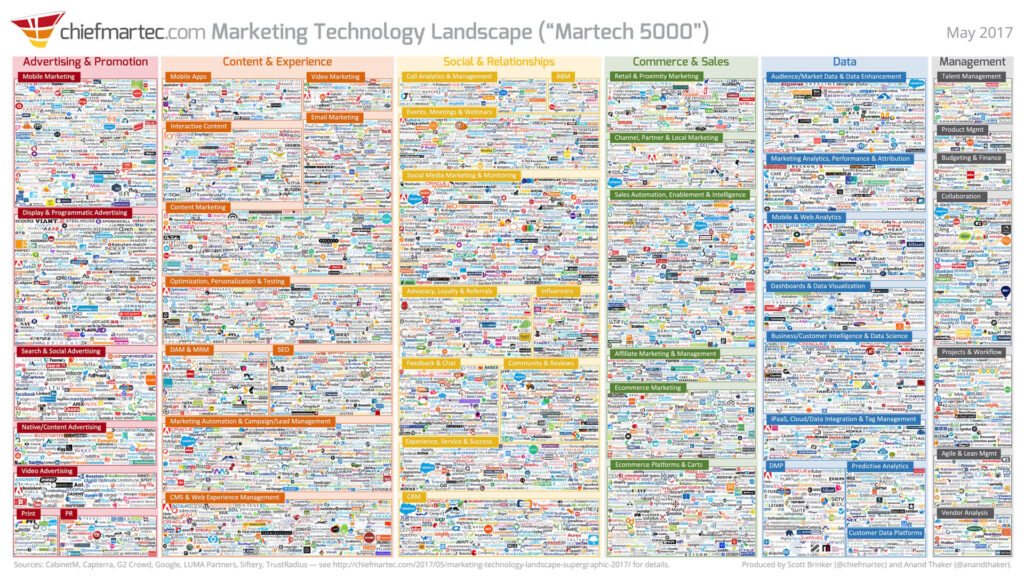Marketing technology is essential for every business today.
It’s impossible to execute any marketing tactic without some kind of software, app, or tech.
Back in 2017, you already had more than 5,000 martech tools to choose from:

Fast-forward to April 2020, and nearly 58,000 software companies are listed on G2.
With so many choices, you’d think learning how to build a martech stack would be easy, right?
Quite the opposite.
The same martech stack your competition runs isn’t necessarily ideal for your brand. It doesn’t get much more personal than building your stack. What you run should be unique to your needs, size, and goals.

Martech Stack Definition: What is a Martech Stack?
Simply put, a martech stack is a collection of tools you use to improve marketing processes. They can include tools for niche processes like social media, data collection, or customer experience. A martech stack might also include all-in-one tools that function as a hub for your other marketing tools.
Most martech tools include something called an API. An API is a type of code that lets different pieces of technology securely communicate with each other. For example, you would use an API to add your Mailchimp email capture form to your website. Another API might add social share numbers to your on-site share buttons. You can also use APIs to share large datasets by merging tools like Google Analytics and Salesforce.
How Important is a Martech Stack?
Very. The average company devotes 30% of its marketing budget to technology. Your marketing technology stack can take your business in one of three directions:
- You build a bloated martech stack with more features than you’ll ever need for your business size. Your martech tools aren’t properly integrated, and no one knows how to use everything. Your marketing budget vanishes each month and produces little to no ROI.
- You’re afraid of a bloated martech stack, so you play it too safe. You only use a handful of tools and don’t experiment with new features. Your productivity slows because your martech can’t keep up.
- You figure out how to build a martech stack that has all the features you need and room to grow as needed. Your martech tools don’t overlap, so you’re not wasting funds on unnecessary technology. You see ROI, improved productivity, and better leads.
Obviously, you want to fall into that last category.
Just like you wouldn’t want to overdo it with too many supplements, the same is true of your martech stack. However, you also want to make sure the tools you use will meet your current business needs with some room to grow.
How to Build a Martech Stack Step-by-Step
Your martech stack can either deliver incredible ROI month after month or turn into a massive money pit. Fortunately, you can improve your chances by following a few steps.
Nail Down Your Goals
There’s a martech tool for every task in your marketing department – that doesn’t mean you need them all.
Look for areas that need some improvement or help, such as:
- Conversion rate optimization
- Lead scoring
- Lead quality
- Content organization
- On-site experience
- Lead verification
- Data cleansing
What do you want your martech to accomplish for you?
Get Everyone on the Same Page
You can’t make martech tools work if everyone in the marketing department isn’t on board. People should feel compelled to take charge of certain processes and learn to use the innovative technology.
Everyone needs a growth mindset so they can cooperate across other departments like sales. Getting marketing and sales on the same page is critical.
Audit Your Current Tools and Manual Processes
Look at every piece of technology in your arsenal any member of your marketing team uses – from social media scheduling and email marketing to CRM and content management.
Use a spreadsheet to identify each tool. Include each tool’s full range of features, monthly cost, and what features you use in practice.
Figure Out What Features and Tools You’ll Need
Go back to your list of goals/needs while you have your list of current tools handy.
Where are the gaps? Which tools offer features you’re not using yet but should? Which tools can you cut because they overlap?
By now, you should have an idea of what martech solutions you need.
Look for Areas to Automate and Speed Up Human Processes
Look for additional tasks you could free up or improve with automation.
For example, Hushly’s AI engine improves your lead verification process and adds hyper-personalization to your website – making your content work harder for you.
Remember, you want a growth mindset, so learning how to build a martech stack should push you to a new level of efficiency and productivity – not keep you stagnant.
Investigate Tools and Record Each Tool’s Features
Before you buy any new tool subscription, do plenty of research.
Add potential solutions to your audit list and compare features to what you already have.
Make sure to include prices in your list at this point so you can figure out where to make budget cuts without sacrificing capability.
Some potential areas could include:
- Content management
- Advertising and PPC
- Email marketing
- Event planning
- Social media scheduling and listening
- Content development and trends
- Customer service and chatbots
- Relationship management
- Intent data tracking
- Digital experience and personalization
- Analytics
Put Your Martech Stack into Action
Now it’s time to buy what you need and implement the features!
You’ll have to integrate new tools on two levels: with current technology and across your marketing team.
Evaluate your goals, results, and budget every quarter to track your stack’s ROI.
How to Build a Martech Stack That Works for Your Personalization Needs
Hushly is in the business of helping brands build a martech stack that works for them. The Hushly AI engine is a plug-and-play tool that improves lead conversion, lead quality, content engagement, mobile experience, and much more.
The Hushly AI engine also prevents fake leads from entering your system with verification and streamlines the lead collection and nurturing process.
Learn how to build a martech stack with everything you need and nothing you don’t by reading our eBook on bloated martech stacks.

